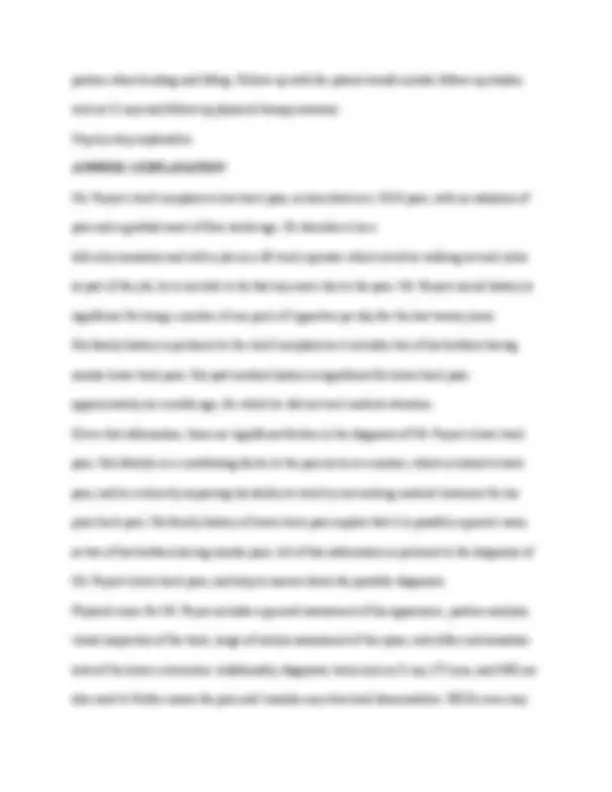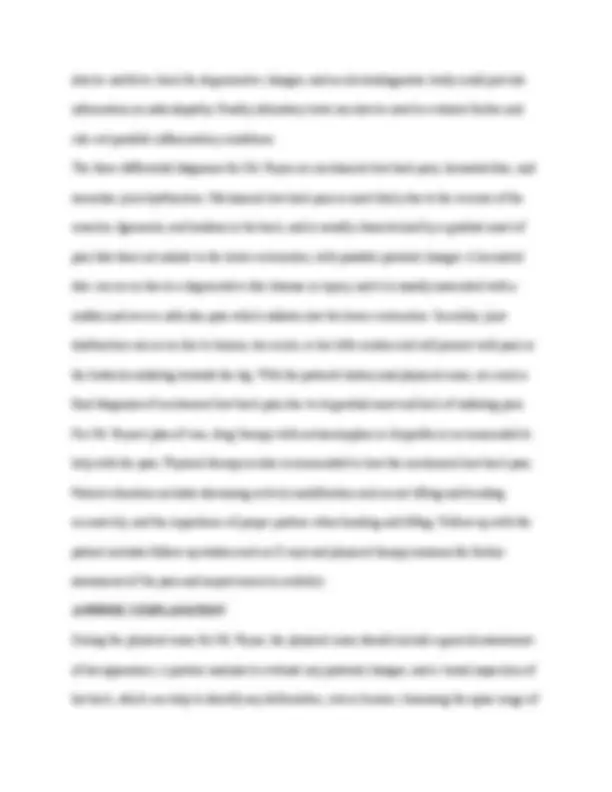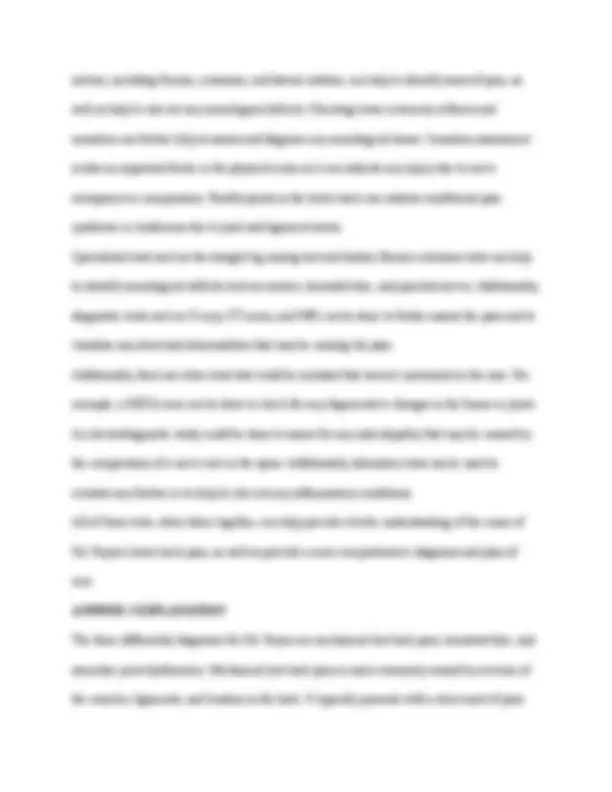






Study with the several resources on Docsity

Earn points by helping other students or get them with a premium plan


Prepare for your exams
Study with the several resources on Docsity

Earn points to download
Earn points by helping other students or get them with a premium plan
Community
Ask the community for help and clear up your study doubts
Discover the best universities in your country according to Docsity users
Free resources
Download our free guides on studying techniques, anxiety management strategies, and thesis advice from Docsity tutors
AQUIFER: Family Medicine 10: 45-year-old male with low back pain Week 5 Discussion: Family Medicine 10: 45-year-old man with low back pain This week, complete the Aquifer case titled "Family Medicine 10: 45-year-old man with low back pain” Apply information from the Aquifer Case Study to answer the following discussion questions: 1. Discuss the Mr. Payne's history that would be pertinent to his genitourinary problem. Include chief complaint, HPI, Social, Family and Past medical history that would be important to know. 2. Describe the physical exam and diagnostic tools to be used for Mr. Payne. Are there any additional you would have liked to be included that were not? 3. Please list 3 differential diagnoses for Mr. Payne and explain why you chose them. What was your final diagnosis and how did you make the determination? 4. What plan of care will Mr. Payne be given at this visit, include drug therapy and treatments; what is the patient education and follow-up?
Typology: Assignments
1 / 8

This page cannot be seen from the preview
Don't miss anything!





AQUIFER: Family Medicine 10: 45-year-old male with low back pain Week 5 Discussion: Family Medicine 10: 45-year-old man with low back pain This week, complete the Aquifer case titled "Family Medicine 10: 45-year-old man with low back pain” Apply information from the Aquifer Case Study to answer the following discussion questions:
Q2: During the physical exam for Mr. Payne, we would assess his general appearance, perform a posture analysis, perform a visual inspection of his back, assess spine range of motion, check lower extremity reflexes and sensation, assess sensation, palpate the lower back and perform specialized tests such as the straight leg raising test and lumbar flexion-extension tests. Additionally, diagnostic tools such as X-ray, CT scan, and MRI can be done to further assess the pain and visualize any structural abnormalities. Additional tests I would have liked to be included were a DEXA scan to check for degenerative changes, an electrodiagnostic study to check for radiculopathy, and laboratory tests to evaluate further or rule out possible inflammatory conditions. Q3: The three differential diagnoses for Mr. Payne are mechanical low back pain, herniated disc, and sacroiliac joint dysfunction. Mechanical low back pain can occur due to overuse of the muscles, ligaments, and tendons in the back. It is usually characterized by gradual onset of pain with no radiation of 0 pain and can come with postural changes. A herniated disc can occur due to degenerative disc disease/injury and can cause severe radicular pain usually with radiation into the lower extremity. Sacroiliac joint dysfunction can occur due to trauma, too much or too little motion and can present with pain in the buttocks radiating down the leg. My final diagnosis is mechanical low back pain due to Mr. Payne's history of pain in the back slowly increasing over time, and not radiating to the lower extremities. Q4: The plan of care for Mr. Payne includes drug therapy with acetaminophen or ibuprofen and physical therapy to treat the mechanical low back pain. Patient education would include discussing activity modification such as not lifting and bending excessively, and using proper
also be useful to check for degenerative changes, and an electrodiagnostic study could provide information on radiculopathy. Finally, laboratory tests can also be used to evaluate further and rule out possible inflammatory conditions. The three differential diagnoses for Mr. Payne are mechanical low back pain, herniated disc, and sacroiliac joint dysfunction. Mechanical low back pain is most likely due to the overuse of the muscles, ligaments, and tendons in the back, and is usually characterized by a gradual onset of pain that does not radiate to the lower extremities, with possible postural changes. A herniated disc can occur due to a degenerative disc disease or injury, and it is usually associated with a sudden and severe radicular pain which radiates into the lower extremities. Sacroiliac joint dysfunction can occur due to trauma, too much, or too little motion and will present with pain in the buttocks radiating towards the leg. With the patient's history and physical exam, we reach a final diagnosis of mechanical low back pain due to its gradual onset and lack of radiating pain. For Mr. Payne's plan of care, drug therapy with acetaminophen or ibuprofen is recommended to help with the pain. Physical therapy is also recommended to treat the mechanical low back pain. Patient education includes discussing activity modification such as not lifting and bending excessively, and the importance of proper posture when bending and lifting. Follow-up with the patient includes follow-up studies such as X-rays and physical therapy sessions for further assessment of the pain and improvement in mobility. ANSWER 2 EXPLANATION During the physical exam for Mr. Payne, the physical exam should include a general assessment of his appearance, a posture analysis to evaluate any postural changes, and a visual inspection of his back, which can help to identify any deformities, cuts or bruises. Assessing the spine range of
motion, including flexion, extension, and lateral rotation, can help to identify areas of pain, as well as help to rule out any neurological deficits. Checking lower extremity reflexes and sensation can further help to assess and diagnose any neurological issues. Sensation assessment is also an important factor in the physical exam as it can indicate any injury due to nerve entrapment or compression. Painful points in the lower back can indicate myofascial pain syndrome or tenderness due to joint and ligament issues. Specialized tests such as the straight leg raising test and lumbar flexion-extension tests can help to identify neurological deficits such as sciatica, herniated disc, and pinched nerves. Additionally, diagnostic tools such as X-rays, CT scans, and MRI can be done to further assess the pain and to visualize any structural abnormalities that may be causing the pain. Additionally, there are other tests that could be included that weren't mentioned in the case. For example, a DEXA scan can be done to check for any degenerative changes in the bones or joints. An electrodiagnostic study could be done to assess for any radiculopathy that may be caused by the compression of a nerve root in the spine. Additionally, laboratory tests can be used to evaluate any further or to help to rule out any inflammatory conditions. All of these tests, when taken together, can help provide a better understanding of the cause of Mr. Payne's lower back pain, as well as provide a more comprehensive diagnosis and plan of care. ANSWER 3 EXPLANATION The three differential diagnoses for Mr. Payne are mechanical low back pain, herniated disc, and sacroiliac joint dysfunction. Mechanical low back pain is most commonly caused by overuse of the muscles, ligaments, and tendons in the back. It typically presents with a slow onset of pain
education and counseling should include discussing activity modification, such as not lifting and bending excessively, as well as proper posture when bending and lifting. Follow-up with the patient is also an important part of the plan of care. Follow-up studies such as X-rays can be done to further assess the pain. Follow-up physical therapy sessions can also be prescribed to assess the patient's progress and ensure that the mechanical low back pain is being properly treated. In terms of patient education and counseling, it is important for Mr. Payne to understand the importance of avoiding activities which could aggravate the pain, such as prolonged sitting, and to understand the importance of maintaining proper posture when lifting or bending. Additionally, Mr. Payne should be encouraged to partake in activities such as walking or biking to help aid in the healing process. In terms of follow-up, Mr. Payne should be seen on a regular basis to assess the progress of his treatment. It is important to note that the treatment of mechanical low back pain may take several weeks or even months, depending on the severity of the pain, and the patient should be made aware of this fact. The follow-up visits should be used to evaluate the progress of the treatment, adjust the treatment plan if necessary, and answer any questions or concerns the patient may have regarding their treatment. REFERENCES